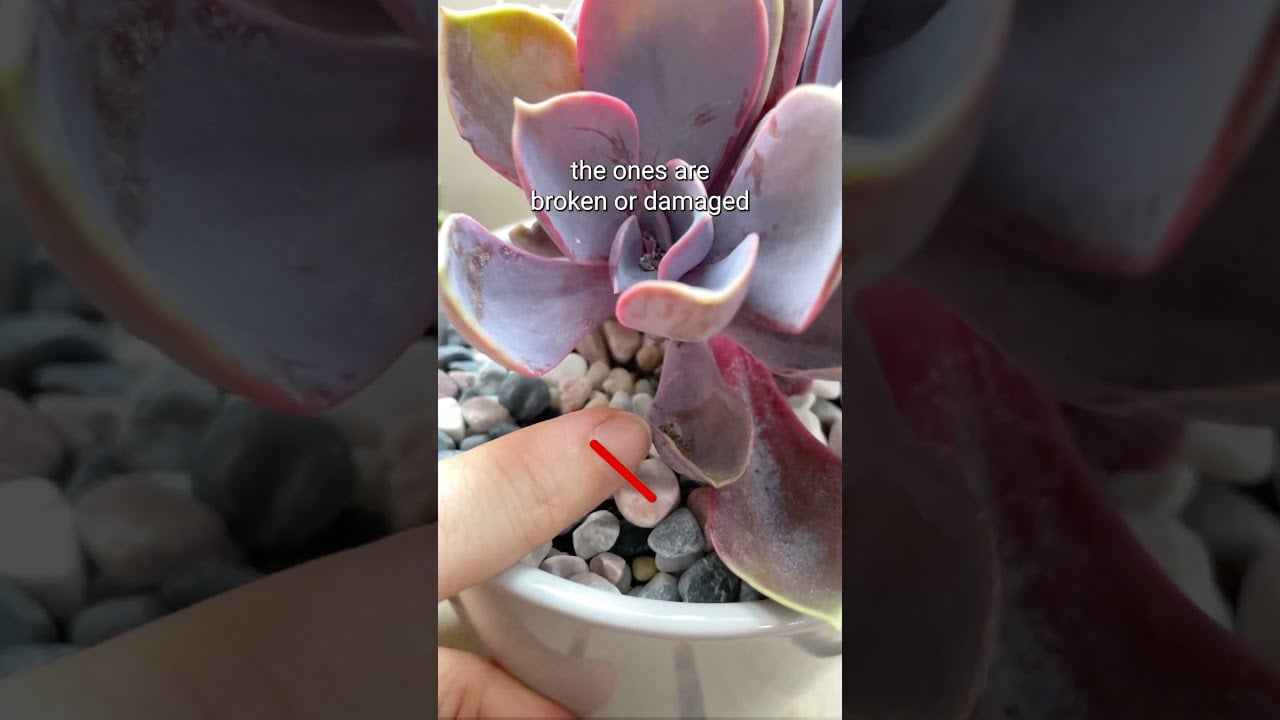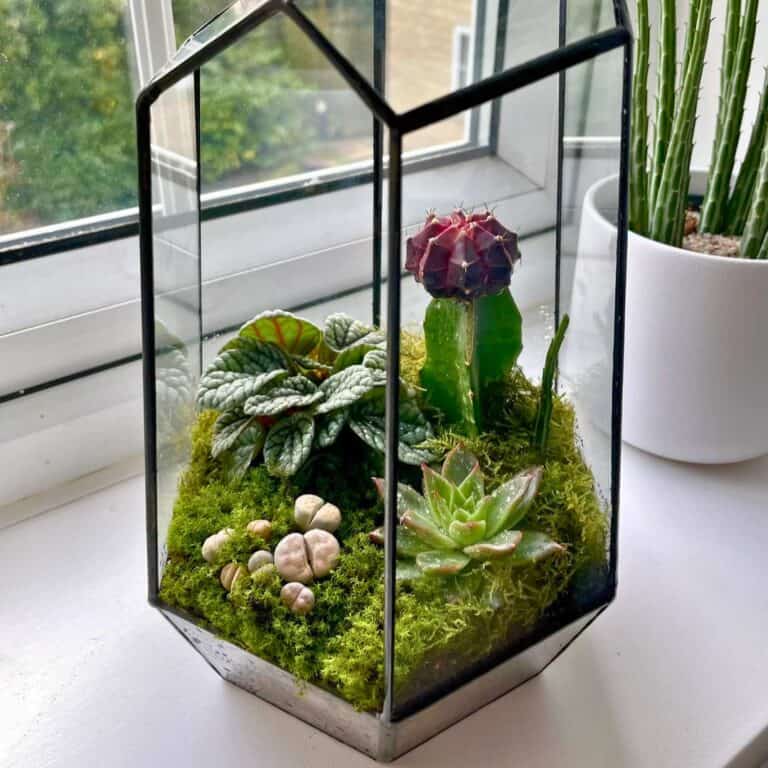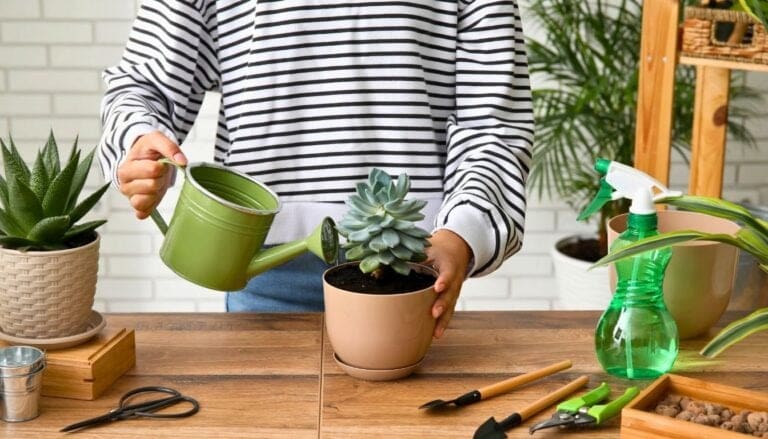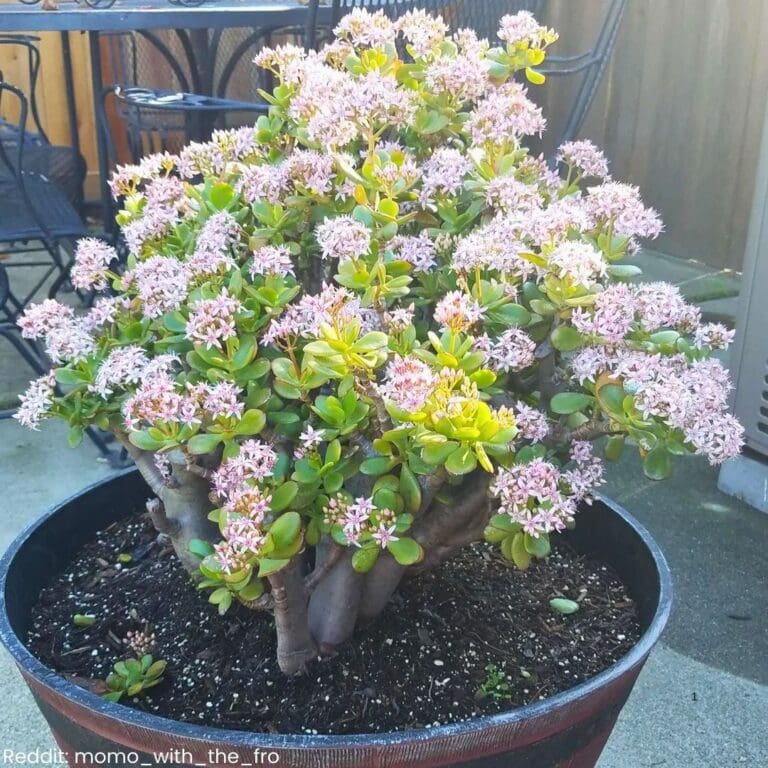7 Tips to Root a Succulent Leaf Like a Pro!
Succulents are some of my favorite plants to grow at home. They’re easy to care for and bring a little green into any room.
Have you ever wondered how to take a single leaf and turn it into a whole new plant? It’s simpler than you might think!
When I first tried rooting succulent leaves, I was amazed at how quickly they grew. It’s a fun project that anyone can do, and it’s pretty rewarding to see new roots form. 🌱
Curious to learn how? Let’s dive in and explore together!
Please note: Simplify Plants is reader-supported. As an Amazon Associate, I earn from qualifying purchases made by our readers with no extra cost added to you all! Some links in the post are affiliate links and I get a commission from purchases made through links in the post.
1) Choose a Healthy Leaf
When starting the journey of rooting a succulent leaf, picking the right leaf is super important.
I usually look for a leaf that’s plump and firm. A healthy leaf is like the superhero of the plant world! This means no spots, no wrinkles, and no blemishes. 🌱
When I gently twist and pull a leaf from the stem, I make sure it comes off cleanly. If part of it gets left behind, it might not grow new roots.
It’s like if you tear a page out of a notebook and half of it stays behind—not ideal!
I also have to make sure I’m not choosing a leaf from the center of the plant. The outer leaves are my best bet. They’re older and ready to grow.
It’s like choosing a ripe avocado from the store. 🥑 Who knew picking leaves could be so much fun?
Sometimes I feel like I’m playing a game—spotting the strongest leaf from the bunch! And who doesn’t love a little plant treasure hunt? 😄
Besides, picking the right leaf makes the rooting process smoother and often faster. An unhealthy leaf can struggle to thrive, making me feel like a worried plant parent.
In my experience, healthy leaves lead to healthy new plants. So make sure to scout for the best leaf you can find!
2) Allow the Leaf to Callous
When I first started rooting succulents, I wasn’t sure why letting the leaf callous was so important. Turns out, it’s key to success! 🌱
This step helps protect the leaf from rot and creates the right environment for new roots to grow.
I always lay my succulent leaves out on a dry, sunny spot. A windowsill works great if you’re extra careful. If you’ve got curious pets or a breeze blowing, place them somewhere safe, away from hazards. Do you have a favorite spot for this kind of thing?
It’s important to wait a few days before moving on.
It’s like leaving a bandage on—gives the cut time to heal. ⏳
Touch the edge of the leaf gently. If it’s dry and not sticky, it’s ready!
I’ve learned the hard way that rushing this process can cause the leaf to rot instead of root. Not ideal, right? 🙈
Who else has learned a plant lesson the tough way?
Remember, patience pays off big time in plant care! 💚
If you’re ever unsure about whether your leaf is calloused enough, I suggest checking it again with the touch test. Better safe than sorry. 😅
3) Place in Well-Draining Soil

Succulents need well-draining soil to grow healthy roots.
I learned this the hard way when I overwatered my first succulent. The poor thing never stood a chance in the dense, waterlogged soil! 😂 Don’t make my mistake.
I look for cactus or succulent soil mix at garden centers.
You can also make your own by mixing regular potting soil with sand or perlite. This keeps the soil loose and lets air reach the roots.
It’s like giving your succulent a comfy bed to grow in! 🌱
Have you ever touched wet soil and noticed how heavy it gets? That’s not good news for succulents. They prefer lighter, airy conditions.
When I first switched to the right soil, I could almost hear my plants sigh in relief!
Well-draining soil prevents root rot, giving your succulent leaves the best start.
Let’s chat! Do you have a favorite soil mix for succulents? Tell me in the comments below.
And remember, happy soil = happy succulents! 😊
4) Provide Bright Indirect Light
I’ve got a secret for you: succulents are light lovers! ☀️
They need plenty of bright, indirect light to thrive.
If you’ve ever wondered why your plants aren’t growing well, it might be the lighting. No worries though, I’m here to help!
When I nurture succulent leaves, I place them near a sunny window, but not right in the sun’s direct path. This way, they get all the light they need without getting scorched.
Have you noticed your leaves looking a bit sad or stretched out? They might be reaching for more light.
We’ve all been there, right? 😅
Try moving them a little closer to some natural light, but not too close.
I sometimes use a sheer curtain to soften the sunlight coming through. It works like magic! 🌟
These tricks help ensure that my succulent babies get just the right amount of light.
So, have you tried different spots in your home to see where the light is best? Each room can surprise you with the light it provides at different times of the day. Experiment a bit!
Bright light really can make all the difference in rooting those adorable succulent leaves.
Remember, just avoid the intense afternoon sun, and you’re good to go!
Have you discovered the perfect lighting spot yet? Tell me about it! I’m always eager to learn new tips from fellow plant lovers. 🌿
5) Avoid Overwatering

Overwatering can be a common mistake when rooting a succulent leaf.
I used to think the more water, the better. That’s not true for succulents! These plants don’t like their roots to stay wet for too long. 🌱
I once gave my succulent a tad too much water, and it started to look a little sickly.
Do you ever wonder why your leaf isn’t rooting despite all that care? Too much water might be the culprit!
It’s all about balance.
How do I know when it’s enough? I check the soil.
If it’s dry to the touch, then it’s time for a splash of water. If it’s damp, I wait a little longer before watering.
A little trick: if the leaf looks plump and healthy, it might not need watering yet.
Have you noticed your leaf getting wrinkly? That’s a signal it might need a sip.
Make sure to avoid soaking the soil completely.
Trust me, succulents are experts at storing water. They thrive on a bit of tough love.
So I try to hold back on the watering can!
It’s better to wait and let the soil dry out a little. Patience is key! 😊
Let’s connect in the comments! Have you accidentally overwatered yours before? How did you save it? Share your stories!
6) Use Rooting Hormone
I love the magic of growing new life from a simple leaf!
To boost the process, I sometimes use a rooting hormone.
This is like a little secret ingredient that encourages the leaf to start growing roots faster. It feels like giving the leaf a motivational speech to get moving. 🌱
Applying this powder is super easy.
I dip the cut end of the succulent leaf into the rooting hormone before I place it on the soil. It’s almost like dusting a leaf in fairy powder. Who doesn’t want a little extra magic in their garden?
Rooting hormones are available at most garden stores.
They come in powders, gels, and liquids, so I can choose the one I’m comfortable with.
For me, the powder is nice and easy to use. Plus, it’s a great excuse to make a trip to the garden store! Do you love browsing plants too? 🪴
Using a rooting hormone is not cheating—it’s a little extra help. Many gardeners swear by it, and so do I.
It’s like giving my succulent leaves a best friend to help them on their journey to becoming a full plant. 🌿
Sometimes, I like to experiment and skip the hormone. Nature is pretty amazing on its own.
Yet, for those extra special leaves, it’s my little secret weapon. What about you? Would you give it a try? 😊
7) Be Patient

When I first started rooting succulent leaves, I was super eager to see quick results. 🌱
I kept checking them every day, hoping they’d sprout roots overnight. But, you know what? Nature takes its sweet time!
Just like waiting for a good pizza, rooting succulent leaves isn’t fast food.
I remember thinking, “Is anything happening under there?” It can be tempting to give up when you don’t see instant progress.
Have you ever felt like that? The wait can sometimes make us feel unsure.
Patience is a must! Growth is happening, even if you can’t see it right away.
Trust me, the wait will make the first sign of roots even more exciting. It’s like a little celebration each time I spot a tiny root peeking out! 🎉
Remember to keep your leaf in a spot where it gets some indirect light and proper airflow. Then, just leave it there to do its thing.
Checking it less often can help—it’s like letting a friend surprise you. 😂
So, grab a cup of tea, maybe even check out a new book while you wait. Your succulent leaves will reward your patience with healthy roots. Do you have any fun waiting stories to share? 🌿
Understanding Succulent Leaves
Succulent leaves store water in their thick, fleshy tissues. They come in many shapes, sizes, and colors. Let’s explore their unique anatomy and popular types you might love to grow. 🌵
Anatomy of a Succulent Leaf
Ever notice how thick and plump succulent leaves are? They have a fleshy structure that helps store water for drought periods.
Inside, there’s mostly water and mucilage—a jelly-like substance. This makes them great survivors!
Their outer layer, the cuticle, is a kind of natural shield. It keeps the moisture in and the pests out. The cells inside are packed with water, giving them that iconic texture.
Have you ever squeezed one lightly? The juicy feel is thanks to all that stored water. Succulents are resourceful, aren’t they? 💧
Common Types of Succulents
There are so many types!
Aloe Vera is a favorite for those gel-filled leaves. Perfect for soothing sunburns!
Then there’s the elegant Echeveria with its rosette shape. Looks like a beautiful green flower, don’t you think? 🌺
Jade Plants have cute round leaves and bring a sense of calm. People say they bring good luck, too. Who couldn’t use a bit of that?
And let’s not forget Sedum! They are hardy and spread quickly.
Which one would make the perfect green buddy for your home? 🌿
Preparation for Rooting

Before we jump into rooting a succulent leaf, it’s key to start with the right materials and choose the healthiest leaf possible. This sets us up for success and makes caring for the leaf much easier.
Ready to get messy and play plant doctor? 🌱 Let’s dive in!
Choosing a Healthy Leaf
I always start by picking a strong and plump leaf from the succulent. Avoid any that are damaged or discolored. If the leaf is thin or wrinkled, it might not root well.
It’s like a plant version of picking a superhero—only the best will do!
Hold the leaf close to the stem and gently twist to remove it. Make sure you get a clean break without any leftover chunks on the stem.
Do you see any leaves ready for the job in your collection? A happy leaf is step one to a happy plant! 🍃
Tools and Materials Needed
Let’s talk tools! You don’t need much, which is great news.
I gather a small container, some well-draining soil mix, and a spray bottle for misting.
You’ll also want a bright spot (indirect sunlight is ideal) for the magic to happen.
A pot or a tray, whichever you have at hand, works wonders. Just make sure they have drainage holes.
A little humor: plants dislike soggy feet as much as I do after a wet day. 🌧️
Oh, and don’t forget about the sunbathing spot—because who doesn’t like a good tan? ☀️
Rooting Techniques
Getting a succulent leaf to sprout roots can be a fun project!
Whether you try using water or planting it in soil, both methods can work like a charm if done with a little care. 🌱
Let’s dive into the details below to get those little leaves growing strong!
Water Propagation

I love putting leaves in water to watch the roots grow.
First, pick a healthy leaf and set it on a dish to let the edge dry for a day or two.
Then, place it in a shallow dish with just enough water to touch the base. Use something like a small shot glass or a lid to hold the water.
Change the water every few days to keep it fresh.
After a week or two, tiny roots should start to appear! Isn’t it cool to watch them grow?
Keep the water level low, as too much can drown the leaf.
When the roots are about an inch long, it’s time to transfer the leaf to soil.
Do you think you’ll try this technique? 😊
Soil Propagation
Planting in soil is a classic way to root a succulent leaf.
I usually start by taking a plump, healthy leaf and letting it dry out for a couple of days. This helps prevent it from rotting once planted.
After that, I lay it flat on top of some succulent soil.
A small tray or pot works best.
Water the soil sparingly every few days, just enough to keep things slightly damp. Too much water can do more harm than good, so go easy!
You should start to see roots in about 2-4 weeks.
Once they grow, a little rosette will form at the tip. Watching it happen is incredibly satisfying. Ever tried this yourself? It’s like magic! 🌟
Aftercare and Maintenance
Taking care of your newly rooted succulent leaves is crucial for their growth.
I’ll guide you on how to successfully transplant them and provide essential tips for ongoing care. Let’s keep those little plants thriving! 🌱
Transplanting Rooted Leaves
Once your succulent leaves have healthy roots, it’s time to move them to a real pot.
I find small pots work best, so there’s not too much space. Picture it as their first apartment! 🏠
Use well-draining soil—cactus mix works great.
I like to gently place the rooted leaf right on the soil surface.
Water sparingly, just enough to keep it slightly damp. Overwatering is a rookie mistake we all can make.
Don’t place them in direct sunlight immediately. Let them adjust first.
A little morning sun is perfect, like easing into a warm bath.
Remember, succulents love light but can get sunburned if they’re exposed too quickly.
Ongoing Care Tips
Regular care helps them grow strong.
Do you like schedules? So do your plants! Set a routine for watering.
I check the soil moisture with my finger—when the top inch feels dry, it’s time.
For light, I keep mine near a sunny window. But when the sun gets fierce in summer, I pull them back a bit.
Have you ever been too hot at the beach? Your succulent knows the feeling! 🌞
Every few months, give them a gentle fertilizer nudge.
I use a diluted succulent fertilizer. They’re not heavy eaters, just a little snack will do. 🥤
Engage with your plant. Talk to it, play music, or name it something goofy.
It’s more fun than you might think, and who doesn’t need a little company?
Feel free to share a photo of your succulent in the comments! 📸
Frequently Asked Questions
Ever wondered how to successfully root a succulent leaf? I’m here to guide you with helpful tips and tricks. From soil types to growth times, I’ve got you covered. Let’s dive in! 🌵
How do I get a succulent leaf to root?
Start by choosing a healthy leaf. Gently twist it off the plant and let it callous over for a few days. This prevents rot. Patience is key, and soon enough, you’ll have roots forming.
What are the steps to propagate succulent leaves in water?
Fill a shallow dish with water and place the leaf above it. It’s best to let the edge of the leaf just touch the water. Check regularly to make sure it’s not submerged. 🌱
What is the best soil for propagating succulent leaves?
Use well-draining soil. Cactus mix or soil with added sand is perfect. The goal is to prevent your leaf from sitting in soggy soil. 😉
How long does it usually take for a succulent leaf to start propagating?
It usually takes two to four weeks. Factors like light, temperature, and leaf health can affect this. Keep an eye out for tiny roots and shoots!
What methods can I use to stimulate root growth in succulents?
Use bright, indirect light and water sparingly. This encourages the leaf to search for water by growing roots. Fertilizer can help, but use it sparingly!
Can you root a succulent leaf by placing it directly into the soil?
Yes, you can! Simply let the leaf callous, then lay it on top of the soil.
Lightly mist now and then, but be careful not to overwater. Watch the magic happen! ✨
Note: Some images in the articles are sourced from Reddit and Other Platforms For Reference Purpose.







